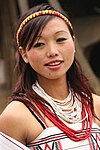Bodo–Kachari people
Bodo–Kacharis (also Kacharis or Bodos)[1][2] is a name used by anthropologists and linguists[3] to define a collection of ethnic groups living predominantly in the Northeast Indian states of Assam, Tripura, Meghalaya and West Bengal.The belief that Bodo–Kacharis were early settlers of the river valleys is taken from the fact that most of the rivers in the Brahmaputra valley in Assam and Arunachal Pradesh today carry Tibeto–Burman names of Kachari origin—Dibang, Dihang, Dikhou, Dihing, Doiyang, Doigrung etc.—where Di/Doi- means water in Boro-Garo languages,[4] and many of these names end in -ong, which is water in Austroasiatic.[3] This umbrella-group includes such sub-groups as Mech in Bengal and Nepal; Boros,[13] Dimasa, Chutia, Sonowal, Moran, Rabha, Tiwa in Assam, and the Kokborok people in Tripura and Bangladesh.[23] One of the earliest usage can be found in the 16th century Assamese language Bhagavata,[24] where the word Kachari is used synonymously with Kirata in a list that mentions Koch and Mech separately.It is generally believed that when the first Tibeto-Burman speakers entered the Brahmaputra valley, it was already populated by people speaking Austroasiatic and probably other language.[30][31][32] Bodo-Kachari community traditions as well as scholars agree that they came from the north or the east;[33] and current phylogenetic studies suggest that the Boro–Garo language descended from Proto-Tibeto-Burman in Northern China near the Yellow River.[34] Linguists suggest that the initial ingress took place 3000 years before present or earlier,[35] and that the immigrant proto-Boro–Garo speakers were not as numerous as the natives.[36] Linguists find the Boro–Garo languages remarkable in two aspects—they have a highly creolised grammar, and they extend over a vast region that radiates out into Nepal and Tripura from the Brahmaputra valley.[38] It is estimated that Austroasiatic languages were present even as late as 4th-5th centuries CE,[39] which is also supported by paleographic evidence from the Kamarupa inscriptions.[40] The heavy creolisation occurred when Boro–Garo emerged as the lingua franca of the Tibeto-Burman and Austroasiatic populations of pre-Kamarupa, Kamarupa and post-Kamarupa kingdoms and polities of Assam,[41] a proposition that other linguists find compelling,[42] The Proto-Boro–Garo first as a lingua franca used for communication across the various linguistic communicates of the region and its striking simplicity and transparency reflect a period when it was widely spoken by communities for whom it was not a native language.Today, the Boros, the Tripuris, and the Garos have established a strong political and ethnic identity and are developing their language and literature.
Naga woman
Boro peopleTripuraMeghalayaArunachal PradeshWest BengalBoro–Garo languagesAssameseHinduismBathouismChristianityTibeto-BurmanKachinethnic groupsNortheast IndianBodo–Garo languagesMising peopleKarbi peopleChutia KingdomDimasa KingdomKoch dynastyTwipra KingdomSanskritisationBrahmaputra valleyeastern HimalayanDibangDikhouDihingDoiyangBoro-Garo languagessilkwormsEkasarana DharmaHodgsonGriersonSino-TibetanLalung (Tiwa)Dimasa (Hills Kachari)TiprasaBodoland Territorial RegionAssamese languageBhagavataKirataBuranjisSarania KachariSonowal KachariDimasaNagameseJingpholanguage shiftsKamarupa inscriptionsKamarupaBangladeshChutiaDima Hasao districtHajongKamatapuriThengal KachariTripuriKokborokGoalparaKamrupMech peopleBoro languageDimasa peopleChutia peopleChutiasSarbananda SinghaMoran peopleMoran languageDeori peopleTiwa (Lalung)Tripuri peopleManikya dynastyKingdom of TripuraMughalsBurmeseGauhati UniversityAnderson, J. D.Burling, RobbinsGrierson, George A.Neog, MaheswarMotilal BanarsidassBibcodeScheduled tribes ofBhariaBhumijBhutiaBirhorBodo-KachariChakmaChenchuDhankaIrulasKhondsLepchaMishingMudugarRabariSantalHill tribes of Northeast IndiaMizoramDimasa (Kachari)Khasi and JaintiaSynteng or PnarLyngngamKuki TribesMan (Tai speaking)Mizo (Lushai) tribesMikir (Karbi)Naga tribesPawi (Lai)Synteng (Pnar)YimkhiungNagaNagalandKhasi Synteng or PnarLakher (Mara)Abor (Galo)Aka (Hruso)ApataniDafla (Nyishi)GalongKhowa (Bugun)MishmiMiju MishmiChugpaLishipaTangsa